What we have inherited is the nation state as conceptualised later on in the Soviet period. It is an ethnic nationalism centered on statehood, the premise being that a particular ethnic group should reside within its own state, and that it owns everything located on that territory.[1]
– Kamol Abdullaev
On January 5, 2009, in his state of the nation address, Tajik President Emomali Rakhmon publicly stated that his nation’s future prosperity solely relied on the successful construction of the Roghun hydroelectric dam.[2] Rakhmon also announced to the world his intent to re-ignite construction of the Soviet-era project and “referred to the construction of the dam as ‘our national idea’ and a ‘battlefield’ for ‘national pride and honor.’”[3] Located on the Vakhsh River in southern Tajikistan, Roghun is projected to be the tallest dam in the world at 335 meters in height.
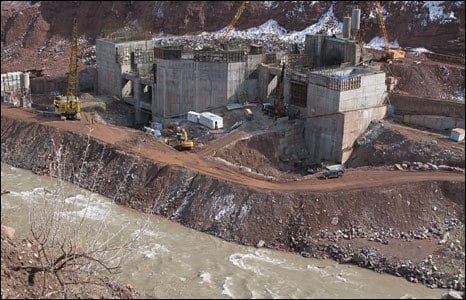
Figure 1: Roghun in construction, February 2010.
The highly controversial nature of Roghun hasd made it difficult for Tajikistan to receive substantive funding from neighboring states and external organizations. Its extreme height, location in a seismic zone, and potential to reshape power relations in Central Asia have kept most potential external investors from committing to the project.[4] Uzbekistan, located downstream from the project, has made accusations that Roghun would turn the dammed river into political capital that could be used against Uzbek interests. This led to cancellation of a Russian investment contract and a falling out with SinoHydro, a Chinese company initially interested in investment.[5]
Forced to seek funding internally, Rakhmon initiated a vast public campaign to encourage investment in the dam project. shortly after his 2009 public declaration. This campaign included country-wide billboard advertising. Through this aggressive artistic campaign, “President Rahmon [sic] has successfully harnessed nationalism—primarily of the ethnic Tajik variety—and, to a limited extent, religion (Hanafi Sunni Islam) as a means to win hearts and minds, maintain power, and ensure stability.”[6] But through what ideological framework has Rakhmon attempted to turn his dream of Roghun into reality? In his quest to build Roghun, Rakhmon has utilized Socialist Realism to promote state-based nationalism, as defined by political geographic boundaries, in an attempt to actualize a national project.
This paper first discusses the historical application of Socialist Realism by the USSR within visual art. Second, it deconstructs the artistic campaign attached to Roghun. Third, it analyzes the government policies pursued in relation to Roghun. Finally, it extrapolates meaning derived from Rakhmon’s artistic conflation of Roghun with nationalism.
I. Socialist Realism Redux
Under Stalin, the USSR endeavored to take control of artistic expression in visual and literary art. Boris Groys, Global Distinguished Professor of Russian and Slavic Studies at New York University, argues that this culture of artistic imperialism regarded itself as point zero; the functional end of artistic innovation due to the proclaimed end of political and economic struggles.[7] Thus, aesthetics and politics morphed into the same being, incapable of separating means from ends. Yet Socialist Realism never functioned to describe reality, but rather to actively shape it. The phenomenon depicts “that which has not come into being but which should be created.”[8] In this sense, Socialist Realism is seen as developing as a mimetic function; that is, as Evgeny Dobrenko, Professor of Russian Studies at the University of Sheffield, explains, “Socialist realism [sic] describes a world to the existence of which only it bears witness.”[9]
The world created by Socialist Realism “speaks not of ‘portraying’ positive or negative heroes, but of ‘incarnating’ them by artistic means.”[10] The depicted leader occupies a position literally larger than life; Stalin’s image transformed into “the model for every builder of socialism, the true creator of the new life…the demiurge itself and thus the concluding stage of the dialectical process.”[11] The identity of the artist fades into irrelevance; the leader of socialism takes precedence.
But where does reality reside within Socialist Realism? French theorist Albert Camus in 1959 described the phenomenon as having “no relationship to reality…Reality is openly put at the top of the list, but only so that it is easier to destroy.” Thus, Socialist Realism can seem to only exist in the sense that it is an artistic project incapable of fulfilling the intended endpoint of mimesis—construction of reality. If Socialist Realism actually did accurately depict, and effectively create, reality, then the term would constitute something altogether different. The phenomenon of Socialist Realism exists exclusively in its downfall and thus is marked by its impermanence and inherent inability to create enduring change.
Ultimately, the “goal of Socialist Realism is the production of socialism via the reworking of reality into an ideologically consumable product.”[12] Certainly Tajikistan is not currently a politically socialist nation, but rather a country still transitioning into a Post-Soviet identity. Regardless, the vestiges of socialism remain at play in the promotion of Roghun through a strategy more pronounced than just propaganda. Instead, the application of Socialist Realism attached to Roghun is “a system that engenders a sort of reality, which obliges one to reexamine certain traditional approaches to the subject.”[13] Whereas propaganda exists primarily with the purpose to elicit political change, Socialist Realism seeks to wholly mold the lived experience.
Similarly to Plato’s “Allegory of the Cave,” prisoners of Roghun’s gaze must look at shadowy projections presented by grand puppeteers. These ephemeral figures slide across a screen of red, green, and white; the veritable flag of Tajikistan becomes superimposed upon the continued existence of the nation. Time will tell as to the transience of these images, and more importantly, the impermanence of Rakhmon’s construction of reality.
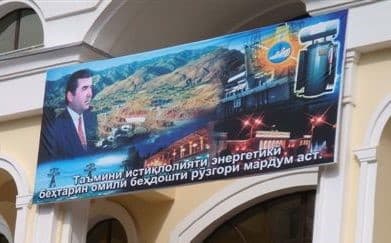
Figure 2 “The guarantee of energy independence is the best factor for the improvement of people’s lives.”[14].
II. Art as Far as the Eye Can See
Every winter, Tajikistan suffers debilitating electricity shortages, putting many citizens in the cold.[15] On November 22 of 2012, Rakhmon pledged to provide adequate electricity access to all citizens at all times of the year.[16] In the image above (Figure 2) Rakhmon looks stately, poised and watchful over his land. Including himself in the image in conjunction with the text demonstrates to the viewer that the country needs energy independence, and energy independence relies on Rakhmon. Similar to images heralding Stalin at the inception of Socialist Realism, a clearly isolated and heroic leader is a common component of this form of art designed to foster a cult of personality.[17] These types of portraits tend to exhibit “a kind of pretended spiritual pathos which is evoked by mysteriously blurred backgrounds-landscapes, skies or townscapes.”[18] Rakhmon takes the foreground (Figures 2,3,6) to ensure his own relevance to the project, while keeping the scenic view of Roghun in the background. In his application of Socialist Realism, Rakhmon presents himself as the undisputed leader ushering in the future of his nation.
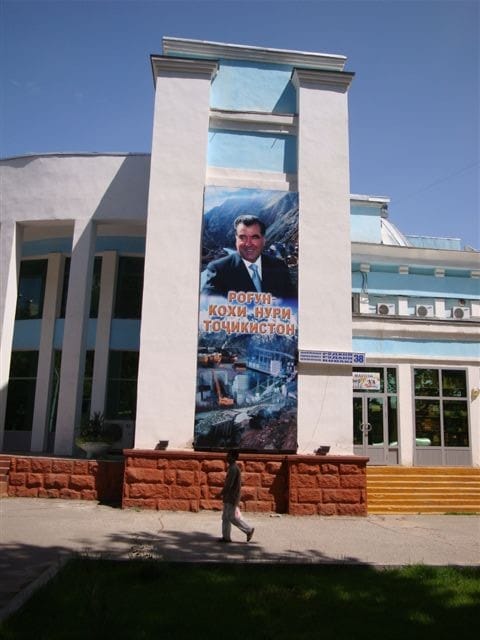
Figure 3 “Roghun is the palace of light of Tajikistan.”[19].

Figure 4 “The hydroelectric plant Roghun means the shining future of Tajikistan.”[25].

Figure 5 “Roghun is the key to state government of every Tajik child and a symbol
of the heights of today and tomorrow.”[26].

Figure 6 “Roghun is the life and death of Tajikistan.”[27].
III. Coercion as Modern Socialism
The purpose of this art, ultimately, comes down to the bottom line – money. Just as the very future of Tajikistan depends on constructing Roghun, Roghun depends on financial investments. On January 6, 2009, Rakhmon made a television address to ask for his people to give to Roghun. Whether these investments were given willingly or not, however, seems an afterthought in the wake Roghun’s necessity. Instead of just accepting the meager investments given by those wealthy enough to invest and still live comfortably, the government pursued a policy to make investments mandatory, thus incorporating the financial aspect of socialism and the ultimate economic goal of Socialist Realism.
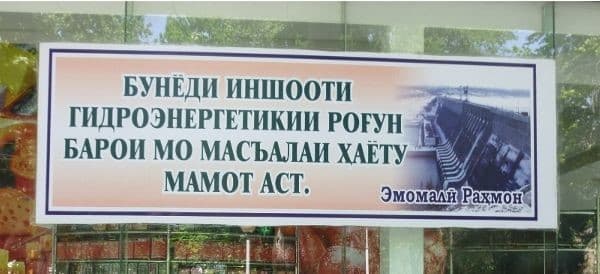
Figure 7 “The construction of the Roghun hydroelectric plant means life or death for us.”[29]A hydroelectric dam is pictured to the right in the billboard.
Yet behind these reports of gentle encouragement to invest, the whole campaign essentially existed as “state sponsored extortion.”[32] The government coerced those on government payroll to work gratis, intimidating them into donating their wages for shares of Roghun; payments were even withheld from salaries. A teacher from Dushanbe
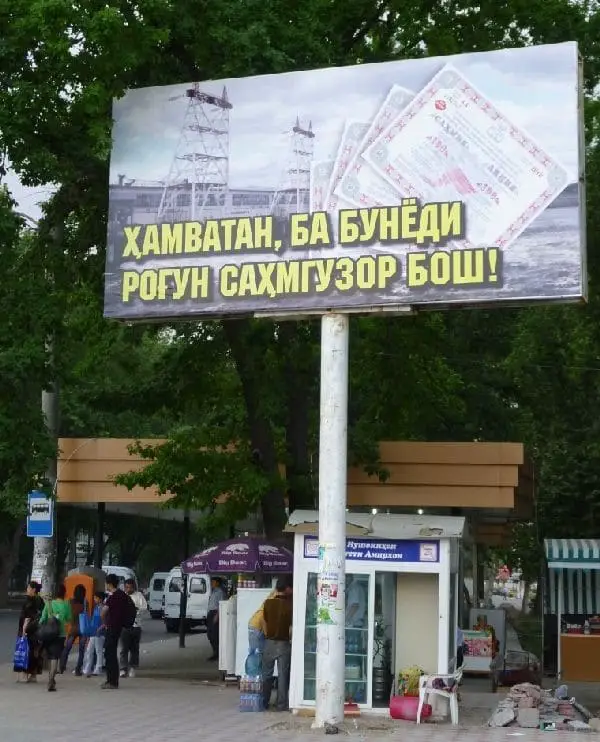
Figure 8 “Fellow countrymen, be shareholders of the construction of Roghun!”
explained that they simply had no choice; they either bought shares or they lost their jobs for not investing in Roghun.[33] Another teacher stated that government officials came to their apartment and threatened to cut off their electricity if they did not buy shares of Roghun.[34] According to a 2010 US Department of State Human Rights report; even “customs officers at Dushanbe’s international airport were required to buy Roghun shares amounting to many times their monthly salaries, with the expectation that they would need to extract bribes to obtain money to buy Roghun shares.”[35]
While those on government payroll were the most vulnerable to extortion, coercion spread through all of society. “Poor villagers had to pool resources to buy one share at TJS 100 ($22.70). Students had to buy between one and four shares. University professors were forced to buy as much as TJS 4,452 ($1,000) in shares; some doctors had to spend as much as TJS 22,261 ($5,000). The country’s few large companies were told to pay many millions of dollars.”[36]
Unfortunately, “the ‘voluntary donation’ initiative [fostered] indignation among the population, some local observers say.”[37] As such, “high-level government officials insisted that the purchases were voluntary, while first-person accounts from low-level officials admitting their use of coercion indicated precisely the opposite.”[38] Thus, when people bought shares, it “[was] not happening out of their will, but out of fear that there [would] be repercussions of their disobedience to the authority of the leadership.”[39] In this regard, images on billboards leapt from their screens and created a culture of fear; mimesis in action.

Figure 8 “Fellow countrymen, be shareholders of the construction of Roghun!”
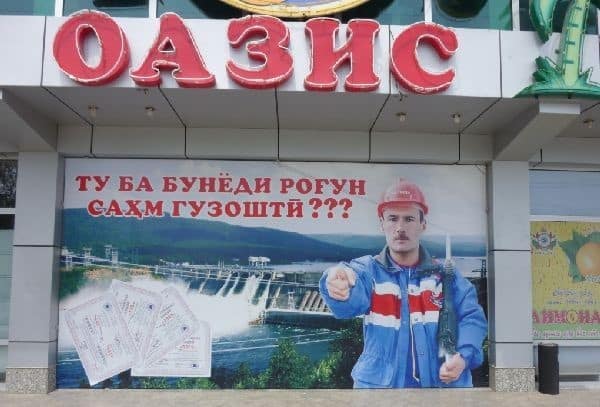
Figure 9 “Have you gotten your shares of the construction of Roghun???”
Figure 9 “Have you gotten your shares of the construction of Roghun???”Urging the population to do their national duty and buy shares, the images above (Figures 8,9) demonstrate Socialist Realism in content and, collectively, they serve to demonstrate it in form. That is, the aesthetic aspect of the billboards depicts the characteristics of Socialist Realism, while the proliferation of these billboards serves to keep Roghun an omnipresent figure in everyday life. Other billboards advertising sales of Roghun shares “[claimed] that individuals and organisations from every segment of society [were] lining up to buy it.”[40] Government reports attempted to galvanize investments through the bandwagon approach; they tried to make buying stocks desirable by making it seem as if everyone was doing it.
Despite an intensive campaign to extort funds from citizens, “the positive picture Rakhmon portrays about the financial capacity of the general public in Tajikistan is in no way near to reflecting the reality on the streets.”[41] In a televised address of October 2009, Rakhmon claimed that of the 1.3 million households in Tajikistan, 1 million had the financial capacity to invest at least $1,500 in Roghun.[42] This projection is quite high, considering that the sum is one and a half times the average annual wages of Tajiks, half of whom live under $2 a day.[43] Yet after only a month of opening Roghun shares to the public, Narzullo Abibulloyev, the Tajik Ministry of Finance’s Head of the Budget Department, claimed to have issued $1.3 billion worth of shares.[44] In reality, however, Rakhmon’s regime only managed to raise just less than $200 million from the general public throughout the duration of the campaign, while an estimated $3 billion is needed to complete construction.[45] After nearly three years of forceful fundraising, the government “stopped selling shares earlier this year [2012] due to a lack of demand.”[46]
Yet some were asked to give more than financial support; they were asked to give up their space for Roghun. In 2010, nearly 1,500 families counting to 6,538 individuals were forced into a resettlement process.[47] It is predicted that by 2015 nearly 7,000 families in the Roghun flood zone will be resettled.[48] Though purportedly given financial restitution and low interest loans, a meager check is no compensation for the fact that nearly 20,000 people, primarily farmers, are being forced to make new livelihoods on arid land.[49]
IV. Roghun: A Liminal, National Space
Through a very public art campaign, Rakhmon attempted to instill a sense of the importance of Roghun in the Tajik nation. Using the techniques of Socialist Realist art, Rakhmon is positioned as the architect of Tajikistan’s future, and the billboards present a zero-sum scenario. Though the dam is not yet functional, this art seeks to sell Tajik viewers on the unquestionable truth of Roghun.
What makes Roghun a manifestation of Socialist Realism is precisely its improbability; it occupies a space which both exists physically and as a specter of the nation. Both tangible and beyond grasp, Roghun’s liminal existence since its 1959 inception will likely remain just that— an incomplete, yet ongoing project.
Acknowledgments: Special thanks go to Geoff Husic, who very graciously translated these billboards on such short notice. These images were neither taken by nor belong to me. I want to thank Glenn Dodge for allowing me to use his photographic work.
Works Cited
“2010 Human Rights Reports: Tajikistan,” US Department of State. April 8, 2011.
Boboev, Jahongir. “Tajiks feel pinch in funding dam,” Asia Times Online. January 6, 2010.
Brown, Matthew C. Art of the Soviets: Painting, Sculpture and Architecture in a One-Party State, 1917-1992. Manchester University Press, 1993.
“Dammed if they do: Spats over control of water in an already unstable region,” The Economist. September 29, 2012.
Demytrie, Rayhan. “Tajikistan looks to solve energy crisis with huge dam.” BBC News. March 23, 2010.
Brien Desilets and Missy Lambert, “Beyond Rogun: The Tajik Hydropower Sector.” January 2011, p. 5.
Dobrenko, Evgeny. Political Economy of Socialist Realism. Trans. Jesse M. Savage. Yale University Press, 2007.
Dodge, Glenn. “Dushanbe Billboards.” April 11, 2010.
Edelman, Murray. Constructing the Political Spectacle. University of Chicago Press, 1988. p. 21.
Ergasheva, Zarina. “Human rights activists about problems facing persons moved from the Roghun dam flooding zone,” Asia Plus. February 6, 2012.
Fer, Briony, David Batchelor and Paul Vood. Realism, Rationalism, Surrealism: Art Between the Wars. Yale University Press, 1993.
Foroughi, Payam. “Tajikistan: Nations in Transit Report,” Freedom House, 2012.
Groys, Boris. The Total Art of Stalinism: Avant-Garde, Aesthetic Dictatorship, and Beyond. Trans. Charles Rougle. New Jersey: Princeton University Press, 1992.
Ibragimova, Rukhshona. “Sharing the power: Voluntary purchase or forced collection?” Central Asia Online. January 9, 2010.
Majidov, Suhrob. “Tajikistan-Uzbekistan Relations Freeze over Roghun Project,” Central Asia-Caucasus Institute. February 17, 2010.
Nabiyeva, Dilafruz. “Tajikistan rations winter electricity: The government and the people are trying to minimize the disruption or reduced winter power supplies.” Central Asia Online, November 13, 2012.
Nichol, Jim. “Central Asia: regional developments and implications for U.S. interests.” Congressional Research Service(CRS) Reports and Issue Briefs. 2011.
Ozcan, Guner. “Tajkistan’s Roghun Project: Daylight ‘extortion’ by the Regime,” Turkish Weekly. March 30, 2010.
Parshin, Konstantin, “Tajiks, Uzbeks spar over Roghun,” Central Asia Newswire. March 8, 2010.
Political Freedom in the World 2011: The Annual Survey of Political Rights and Civil Liberties. Freedom House. Roman and Littlefield, 2011. p. 665
Salbnazarova, Shahodat. “Repairing broken Tajik-Uzbek Relationship: Narrow Vision of nation-state encourages alienation, obstructs solutions to common problems,” Institute for War and Peace Reporting. January 24, 2012.
Sgibnev, Wladimir. “Leuchtende Zukunft – Eine Bilderserie aus Tadschikistan.” November 5, 2010.
Sodigov, Alexander. “The Rogun Dam Controversy: Is Compromise Possible?” Central Asia-Caucasus Institute, May 2, 2012.
“Tajik Hydropower Station to displace thousands,” Radio Free Europe. July 28, 2010.
“Tajikistan: Dushanbe Teachers Feeling Pressure to Make Payments.” Eurasianet. March 28, 2010.
“Tajikistan: Forced Rogun Payments Sowing Discontent Among Impoverished Tajiks.”Eurasianet. January 4, 2010.
“Tajikistan power dam to sweep away ancient villages,” Agence France-Presse. September 21, 2010.
“Tajikistan scraps sales of Roghun shares.” Business New Europe. November 20, 2012.
“Water tensions overflow in ex-Soviet Central Asia.” Daily Times. November 22, 2012.
Footnotes


